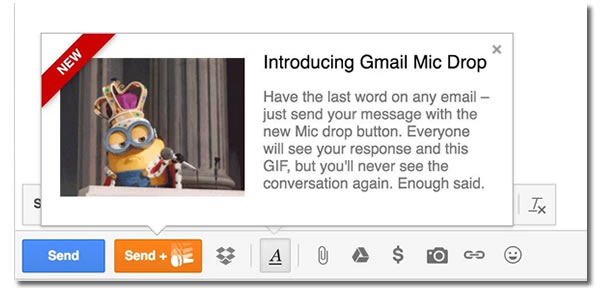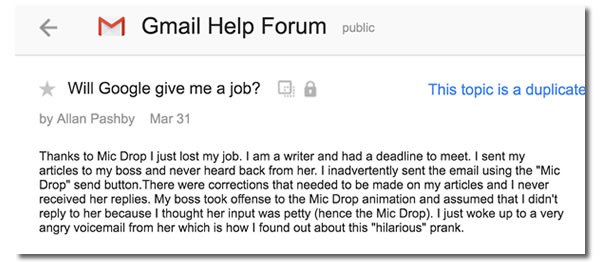
For April Fool’s Day, Google added a “Send this email with a mic drop” button to Gmail, which is a button that allows the sender to have the last word in a conversation. For the first few hours of April 1, 2016, Gmail users starting a new email message saw this:

If you were to send an email with the orange Send + mic drop button instead of the standard blue Send button, your email message gets sent with a couple of key changes:
- It adds an animated GIF of the scene from the Minions movie where Bob the Minion, now King of England, ends a royal address with a “mic drop”, a gesture where a speaker, at the end of a performance or speech, drops the microphone on the ground as a way of saying “I was just so impressive, there’s no point in anyone speaking after me” or “I just won this debate or rap battle”, and
- because the feature is supposed to give you the last word, it ensures that the sender NEVER sees any reply to the email.
When used jokingly among friends while discussing a trivial topic — say, a debate about the 1980s fantasy film Ladyhawke, just like the one in the novel Ready Player One — this feature can be pretty funny. It may strain relations if you use it to reply to a pro-Donald Trump mass email that your ultra-conservative vaguely racist aunt sent out to her large family cc: list.
The problem with the Send + mic drop button is that it’s all too easy to use it by accident. It’s located in about the same place as the plain Send button. The different color should be a dead give-away that something’s different, but given that web apps, especially Google web apps, change their user interfaces quite often, it’s all too easy for someone to click on the new button with unexpected, and possibly unpleasant results.
Here’s one complaint posted to the Gmail Help Forum, posted by someone identifying themselves as Allen Pashby:
It reads:
Thanks to Mic Drop I just lost my job. I am a writer and had a deadline to meet. I sent my articles to my boss and never heard back from her. I inadvertently sent the email using the “Mic Drop” send button.There were corrections that needed to be made on my articles and I never received her replies. My boss took offense to the Mic Drop animation and assumed that I didn’t reply to her because I thought her input was petty (hence the Mic Drop). I just woke up to a very angry voicemail from her which is how I found out about this “hilarious” prank.
Google have since disabled their April Fool’s feature and have updated their blog post announcing it to start with the following paragraph:
UPDATE: Well, it looks like we pranked ourselves this year. 😟 Due to a bug, the Mic Drop feature inadvertently caused more headaches than laughs. We’re truly sorry. The feature has been turned off. If you are still seeing it, please reload your Gmail page.
Lessons you can learn

While I’ve found it instructional to learn from my own mistakes, it’s far more enjoyable and less stressful and embarrassing to learn from others’ mistakes. Here’s what you can take away from Google’s mic drop snafu:
- When you’ve got a platform with a large number of users (the number that gets bandied about when talking about total Gmail users is one billion), you’re going to have a large number of use cases. Many people use Gmail as their primary business email tool, and there’s a good chance that a number of business conversations and relationships were derailed, at least temporarily, by a mic drop message.
- People expect consistency, especially from tools they use daily, and when that consistency is broken, the experience is degraded. Remember what happened when Microsoft removed the start menu in Windows 8?
- When you change your user interface often, people stop noticing user interface changes. As designer Douglas Bowman wrote when he resigned in 2009, their approach to design often takes a test-driven approach, where they present one group of users with one design, another group of users with an alternate design, and they choose the winning design based on user responses. This approach requires performing little experiments which involve making changes to the interfaces that users see. We’ve become so used to these changes that we often don’t notice them until they’re pointed out. Often, these changes are minor, such as the time they showed different users different shades of blue to see which one of 41 possible shades would perform better. However, in cases where the change in behavior is significant, such as with the mic drop, surprising the user can be problematic.
- Warn users when you’re about to perform something “destructive” or radically different. Typically, when you’re about to delete a file, photo, or some other piece of data in an application, you’re presented with an “Are you really sure you want to do this?” message. Google could’ve made a similar message appear after the user pressed Send + mic drop button that explained what was about to happen and offered a way to cancel.
- Nobody’s always alert. This feature was introduced at midnight Pacific time (GMT -7), April 1, 2016, which meant that for a lot of users, it was late at night or early in the morning, meaning that a lot of users were either working late or early, when alertness is low. Coupled with the fact that people stop noticing user interface changes when they change so often, this can lead to trouble.
